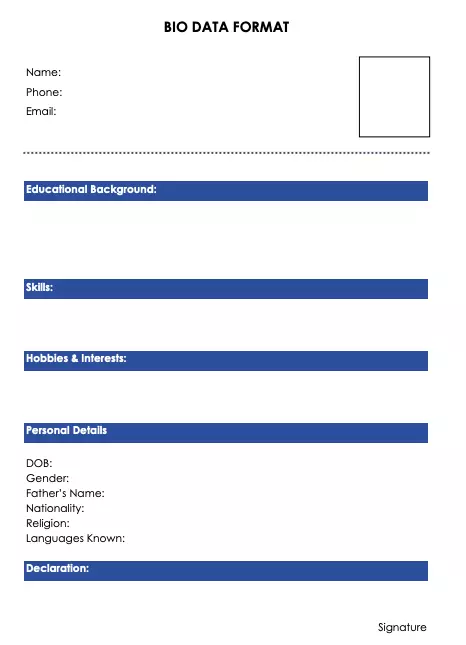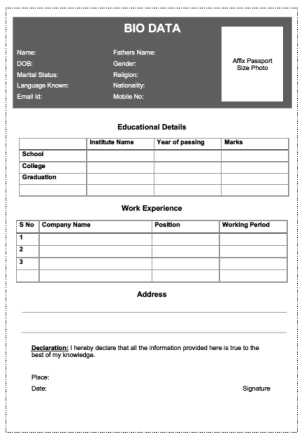Biodata For Job – This article will teach you everything you need to know about biodata, how to write a biodata for a job, biodata format and sample, biodata format for a job, biodata format pdf, and more. Please see the details below for more information.
Biodata Format For Job
Biodata is a database that stores information about you, such as your date of birth, gender, ethnicity, nationality, place of residence, marital status, parents’ names, contact information, current job, salary, and other personal information. A resume can also include introductory remarks, education, and experience.
What is Biodata?
A biodata is a collection of basic information about a person’s career, work, and life accomplishments. In many interview/recruitment situations, candidates must introduce themselves, and their work, and explain why they are a good fit for the job. A biodata is the first step in that process, and it has a significant impact on the impact your job application can have on interviewers and potential employers.
Hiring managers use biodata to evaluate a candidate’s ethics, perspectives, values, and experiences. These factors will assist them in determining whether a candidate will fit into their work culture and align with the company’s vision. In many cases, candidates are selected for interviews solely on the basis of their biodata.
How to write Biodata
There are various formats for writing a biodata. However, there are some key pieces of information that you must include in order for it to be complete. To write an effective biodata, follow these steps:
Include a formal photograph of yourself
Hire a professional photographer to take a good passport-size photograph of yourself. Check that your face is clearly visible in the photo. Having formal attire and expression in the photograph is good to practice. Avoid wearing bright colors, jewelry, or too much makeup.
Bio Data Format 1

Bio Data Format 2

Add a personal statement outlining your background and career objectives
A personal statement can serve as an introduction to the following sections. It should include information such as your name, birthplace, current city of residence, most recent job, and most recent formal education. Make sure to highlight or isolate keywords before the body text.
Bio Data Format 3

Provide some basic personal information
You get to choose how much information you want to divulge to a prospective employer. Only include information if you believe it to be essential to the biodata. The inclusion of the entire name, gender, nationality, date of birth, and contact information is customary. To increase exposure, you might present this information as a list with bullets.
Examples:
Basic Information
- Name: Chandra Prakash Singh
- Father’s Name: Prakash Singh Rathore
- Gender: Male
- Date of Birth: August 13th, 1988
- Nationality: Indian
- Contact Number: +91 76453 09622
- Email Address: [email protected]
- Present Address: 223, 2nd Cross Road, BT Layout, Sector 24, Bhopal, M.P.
- Basic Information
- Arshad Ul Islam
- Male
- October 4th, 1994
- Indian
- +91 94487 66107
- [email protected]
Bio Data Format 4

Share your educational background
List your official education, including your degrees and diplomas, your main courses, and your overall grade point average (CGPA) (Cumulative Grade Point Average). Include the years you spent studying for each course as well. Keep in mind that your most recent educational accomplishment should be listed first, followed by the others, in that order.
examples:
Educational Qualifications
- M.Arch | Imperial School of Architecture, Pune | 2017-2019
- Major Subject: Landscape Architecture
- CGPA: 7/10
- B.Arch | State College of Architecture, Mumbai | 2012-2017
- Major Subjects: Architectural Design, Structural Engineering
- CGPA: 6.5/10
Education Background
- MBA | 2016-2018 | National Business School, Chennai
- Focus: Business Studies, Management Consultancy
- Aggregate Score: 73%
- B.Tech in Computer Science Engineering | 2012-2016 | Regional College of Engineering, Calicut
- Focus: Java Programming, Visual Studio Basics, Python
- CGPA: 3.7/5
Bio Data Format 5

Different between Biodata, Resume & CV
Biodata
Personal information such as your name, date of birth, gender, first language, nationality, place of residence, and marital status will be included in your biodata. These details are typically required when applying for a position in a government office or when applying for research grants. A job biodata format also includes a chronological listing of your educational qualifications and previous experience.
An application should take care not to include any information that could lead to data misuse. Furthermore, overseas clients who hire remote freelancers rarely request Personally Identifiable Information (PII). The description should be brief and not exceed one page. This document focuses on you as a person, not on references.
Resume:
A job summary is best described in a resume. The document is a quick review of your previous jobs and positions, as well as the successful projects you’ve worked on. A resume should ideally be no more than one or two pages long. Attaching a resume to an application reveals your core competencies and educational qualifications, which is especially useful when applying for internships. A resume should never include references.
Curriculum Vitae (CV):
Curriculum Vitae (CV) is typically two to four pages long, but if you have anything interesting to add, it may be several pages long. You probably don’t have much work experience because you just graduated. The good news is that you can describe your educational credentials briefly, which will appear at the top of the page.
Describe your academic credentials and professional affiliations. A great CV should include any additional courses you’ve taken, extracurricular activities, and part-time jobs where you’ve gained on-the-job experience. Any research you’ve done is also of interest to talent scouts. You should include information about your talents, hobbies, and technical skills, as well as any other information relevant to the job, in such a summary.
When to Submit Bio-Data/Resume/ CV
Curriculum Vitae (CV) is typically two to four pages long, but if you have anything interesting to add, it may be several pages long. You probably don’t have much work experience because you just graduated. The good news is that you can describe your educational credentials briefly, which will appear at the top of the page.
Bio Data: When your job requires only your basic information, and you don’t have time to create a resume, you can simply print out the biodata and fill them out.
Curriculum Vitae (CV) is typically two to four pages long, but if you have anything interesting to add, it may be several pages long. You probably don’t have much work experience because you just graduated. The good news is that you can describe your educational credentials briefly, which will appear at the top of the page.
Resume: You can use a resume to apply for jobs whenever you have the time and want to describe yourself in greater detail.
CV: A Curriculum Vitae is required when applying for research jobs or scholarships.
How To write biodata for a job?
You should include the following information in your job biodata:
- Personal information includes your full name, address, phone number, and email address.
- A brief statement stating your career goals and what you hope to achieve in the job you’re applying for.
- Education: Include your academic credentials, such as the name of the institution, degree earned, and year of graduation.
- Work experience: Include information about your previous jobs, such as your job title, company name, dates of employment, and key responsibilities and accomplishments.
- List any relevant skills, such as technical abilities, language proficiency, or certifications, that qualify you for the job.
- Mention any notable awards, certifications, or publications that demonstrate your expertise or accomplishments.
- References: It is optional to include professional references’ names and contact information.
Your bio should be clear, concise, and tailored to the specific job for which you are applying. Check it for errors and make sure it accurately represents your qualifications and experience.
Biodata FAQs
What is the purpose of biodata?
The purpose of biodata is to provide potential employers, educational institutions, or other relevant organizations with a summary of an individual’s personal, educational, and professional information. Based on their background, qualifications, and experience, biodata is used to determine if a person is a suitable candidate for a job or admission to a program.
Is bio data different from CV?
Yes, a biodata and a CV (Curriculum Vitae) are two distinct documents. A biodata is a one-page document that includes personal information such as full name, date of birth, place of birth, contact information, educational qualifications, and work experience.
A curriculum vitae, on the other hand, is a detailed document that summarises a person’s education, qualifications, skills, and work experience. CVs are more detailed and typically two or more pages long. It is used as a standard document for job applications and professional development all over the world.
How many pages is a biodata?
Biodata is typically one page long. It is kept brief and to the point because it is intended to provide a concise overview of an individual’s personal and professional information. A biodata can, however, span two pages in some cases, depending on the amount of information required. The key is to organize and present the information in a readable manner, focusing on the most important details and minimizing redundancy.
Read More